« June 2007 | Main | September 2007 »
August 28, 2007
Limited Lifetime Warranty
I must admit that my view of warranties, and my faith in them, is not the best. When I hear "warranty," what comes up in my mind is not a security blanket or the warm fuzzies associated with knowing that I am covered should anything ever happen to my equipment, whatever it may be. Instead, it's mostly feelings of frustration, sarcasm, and at times anger, the kind consumers experience so often. We've been had. Sure, almost anyone will be able to tell of a wonderful experience of warranty replacement and service, and I have some, too. Not many, unfortunately, and that's the problem right there. But I'll relate those anyway, just to be fair: Far and away the best experience in terms of warranty I've ever had was with CostCo. When an almost brandnew Aiwa projection TV stopped working after a few weeks, they gave me a new one, no questions asked. When the new one also crapped out shortly after that, I got another new one, and that one still works, after several years. You might say CostoCo's action was more replacement policy than warranty. I am pretty sure things would have gone a lot less smoothly had I had to take matters up with Aiwa. In any case, as a result of CostCo's terrific handling of my problems, they have a customer for life.
Car warranties? Hah! They almost always find a way around paying for warranty repairs. Or they get you in some other way. So much so that I never go back to the dealership after I buy a new car. The hassle is just not worth it. Supposedly reputable companies like Best Buy who constantly bleat about their service? Well, they were unwilling and unable to repair a three-year-old TV as "the parts are no longer available." Then some independent quoted an absurd fee to just look at it, and Best Buy helpfully offered to sell me a new one. So I googled and diagnosed the problem, and fixed it myself.
What does all that have to do with Scuba? A lot. The several thousand dollars' worth of Scubapro gear I bought last year has lifetime warranties. That is certainly good to know, though lifetime warranties are always a little suspect. Five-dollar tools have them, but replacement generally means $8.99 or so in shipping and handling.
No, my Scubapro gear did not fail, but it was urgently brought to my attention (not by Scubapro where my gear is registered, btw) that I needed to have my gear serviced or else I'd lose my lifetime warranty. Lose it? How? Well, read the fineprint and conditions of the Scubapro Limited Lifetime Warranty and you find that Scubapro only warrants the product for a lifetime "with reasonable maintenance."
What does "reasonable maintenance" mean? It means "... as a minimum, annual servicing in accordance with recommended Scubapro maintenance procedures or their equivalent and performed by an authorized Scubapro dealer." Should you ever need warranty repair, you need to produce the original Scubapro ID card that comes with the equipment and the name of the authorized Scubapro dealer who performed the last annual service, or no warranty service for you, buster. With those requirements, no car I ever owned would have qualified for warranty repairs. Oh, and if service was ever performed by anyone other than an authorized Scubapro dealer, you're out of luck as well.
Anyway, apparently my Scubapro gear had to be serviced or else I'd forever lose my warranty. Unfortunately, as reported a long time ago, my own Scubapro dealer folded three days after I bought all my equipment from him. My local diveshop here in Folsom had been unable to convince Scubapro to bestow dealership status upon them. And so I had to look elsewhere for proper service. Which I did.
I went to the Dolphin Scuba Center, a 65-mile round trip for me, to drop off my equipment for service. "Drop off?" you may ask. "Why didn't you just schedule an appointment, went in and waited while they checked your regulator?" Well, see, that is not the way it works. You drop your gear off and then it may take a week or ten days, or maybe more until they call you. Could be less, could be more. To be honest, that sure surprised me. And, also to be honest, I don't like it one bit. What if a dive trip opportunity came up during this unspecified period of time? Sure, I could probably get rental gear, but I like mine. Anyway, after much paperwork, and an estimate of US$75 to service my Scubapro regulator and AIR2 backup, my gear was carried off to the service department.
All that said, the Dolphin Scuba Center off Highway 80 on El Camino Avenue in Sacramento is awesome. A very large scuba store with so much equipment that I ended up spending two hours just looking around and buying a few things. A friendly owner who introduced himself and talked to me. All good. And I even understand that something your life may well depend on requires extra-special service. Maybe I am too suspicious and too gun-shy when I see so much legalese. But I still do not like to have to wait ten days or two weeks and having to make two 65-mile round trips just to have a regulator service.
Posted by conradb212 at 11:18 PM
August 19, 2007
The Folsom Outhouse
Though not ever destined to achieve the notoriety of Folsom Prison, the Folsom Outhouse is nonetheless remarkable in its own right. Only in California, I suppose, but I'll get to that in a minute.
I was supposed to go diving yesterday. The local diveshop had organized a community service project in the form of an expedition to lift a Toyota 4-Runner out of the American River. Seems there is a rocky place along the American river shore, not that far below Folsom dam and just above Nimbus dam. People jump off a cliff there, hurt themselves, and dump all sorts of stuff. Bicycles are said to be there at the bottom of the river, and apparently a Toyota truck. And maybe some guns or ammo or whatever. The truck somehow fell in, or was pushed in, about three years ago. No bodies or anything, but also not a real good thing. So the owner of Divers Cove in Folsom decided it should come out and organized the whole thing.
I had stopped by the shop Friday and they were testing the lift bags. Two long ones with a lift capacity of 2,000 pounds each, and then a big cushion-like one with a capacity to lift 4,000 pounds. Now a Toyota Forerunner weighs perhaps 5,000 pounds or so, but that's on land. In the water it only weighs the difference between the water it displaces and the water itself. So those lift bags were plenty enough to get the Toyota out of the muck and float it back to a dock.
So on Saturday I packed my gear and headed for the dive shop with Morgan, my 11-year-old son. A good number of people were already there and loaded stuff on pickup trucks. Lots of air tanks. Rigging of all sorts. More people trundled in, some seasoned divers, others recently certified and in need of rental gear. Robert Flores then had everyone sit down at the big conference and training table, cranked up his projector, and used Google Earth to show the dive location and explain the dive plan. He did a marvelous job, all concise and to the point. But it also became clear to me that we could not go. Diving meant boarding a boat to get upstream to the site, and only divers could get on the boat. I was not about to leave my son behind in some park all by himself. Besides, cold water, a current and very low visibility didn't exactly sound too appealing. So Morgan and I decided to go to Folsom Lake instead.
Folsom Lake was where I'd done my certification dives a little over a year ago, but it was hard to recognize the place. Since it is a reservoir, Folsom Lake goes up and down a lot, and this summer the water level is way down. All the boats from the big marina had to be moved to dry land and were filling the parking lots. Not much fun for them. When I had done my C-dives, it'd been fun to dive and look down onto a parking lot. Well, that parking lot was all dry now and we parked there. And not only that, but the lake level was now much lower than the parking lot so that the shoreline was totally different.
Morgan and I decided to take a hike along the shore, which isn't that much fun since the surface is either muck or really sharp crushed rock. He thinks it's hysterically funny to sink calf-deep into the muck in new sneakers. Me, less so. Anyway, we made it a good distance and around some bends and there it was, the Folsom Outhouse. I know, that doesn't sound too terribly appealing, a floating outhouse, but it really wasn't just a floating port-a-potty like they have at construction sites or county faires. This was a neat, tidy, floating structure, nicely anchored perhaps 50 feet off-shore. I am not sure if they relocate it if the lake level is higher or lower, but for now that's where it was. And it just looked so bizarre and comical, floating there that we couldn't stop laughing.
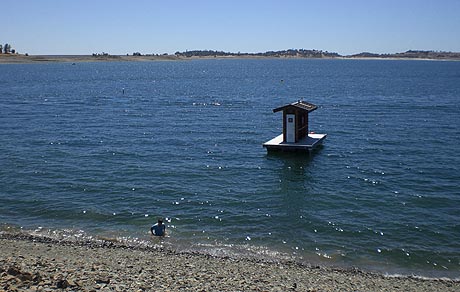
Morgan then went into the water, with all his clothes on, and paddled around. It got deep quickly, but he is a good swimmer and diver. He really wanted to swim over to the Outhouse and check it out, and so I told him he could go. I'd have gone with him, but I had stupidly taken my valuables and other non-waterproof stuff with me and didn't want to leave them laying on the shore. So Morgan swims over to the Folsom Outhouse and tries to lift himself up onto the surface, but it is too high. He tried for a few minutes, then swam back. Shortly thereafter a motorboat approached and docked, and a whole procession of people boarded the Outhouse and used its facilities. Morgan saw the presence of the newcomers as an opportunity to get a lift onto the Outhouse deck and I literally had to hold him back as I didn't want him to crash the pooping party.
So we waited until they were all pooped out, then he swam back and tried again. To no avail.
Why is it there, the Folsom Outhouse? Well, I suppose it's better than to stand on the boat and pee in the lake, but the lake isn't all that big and a suitable facility is likely within five minutes' distance for a motorboat. And it's clearly not for swimmers as there isn't a ladder or anything. So the Outhouse remains a mystery, at least to us. Who did it? How did it come about? How do they maintain it? I guess it's a California thing.
Posted by conradb212 at 11:18 PM
August 14, 2007
Diving the Wall off Rubicon Point, Lake Tahoe
After diving Meeks Bay with its terrific visibility, it was now on to another Lake Tahoe dive site, Rubicon Point at the D. L. Bliss State Park which is just north of Emerald Bay off Route 89. Rubicon Point's claim to fame is a wall dive, with the rock wall falling almost vertically down to over 800 feet.
D. L. Bliss is a large park and the entrance is high up in the mountains and easy to miss. You also want to get there early as the park fills up quickly for campers, and there are only so many parking spots. Entrance is $6, and the park ranger will ask you what you intend to do so they can steer you in the right direction. For diving you want to go to Callawee Cove. After a couple of miles of up and down driving through pristine forest we get to the Callawee Cove parking area that has maybe 15 parking spots. From there it is a steep trail down to the beach with 55 steps. Not something that is a lot of fun to negotiate with full dive gear on, and we brought huge 130 cubic foot steel tanks!
![]()
So we suit up and this time we take along a dive flag float, hoods and gloves. Getting all that gear down to the small cove is challenging enough, but even as we go down we wonder how we're supposed to get it all back up after the dive when we're cold and exhausted and not supposed to exert ourselves too much.
![]()
The water was absolutely crystal clear at the beach and the temperature about 68 degrees. From the parking lot we had seen the usual brilliant blue-green water of Lake Tahoe, but also darker parts and I wondered if that was algae. Turns out it wasn't; it was just clean black sand.
Even after making my way down to the beach it took me a while to cool off and calm down enough to get all my diving gear all set, including the hood and my gloves. I am not used to a hood, and I don't like it any better than wearing a helmet when I race cars. I don't like the constriction and the restricted visibility. And it took me forever to get on my gloves. Sometimes I wonder why all Scuba gear seems to fight you as you put it on. Even though it is not mandatory in California, I am glad we brought the floating dive flag as it doubles up as a carry bag and repository for whatever you don't need at the moment. We also had brought two new underwater cameras to test, the 6.0 megapixel SeaLife ECOshot and the 6.1 megapixel Sealife DC600.
From Callawee Cove you can do all sorts of diving, from hanging around above the shallow sand bottom to spectacular rock areas and to the Rubicon wall. The wall dive is off Rubicon Point - perhaps a 100 yard swim or dive to the south. There isn't much of a current and so it's no big deal. Personally, I recommend diving from Callaway Cove to the Point if you have enough air. There are plenty of cool rocks and boulders in clear, shallow and totally clean water. It does, however, make sense to take along a compass and get a bearing.
![]()
With the big 130 cubic foot steel tanks, air was not going to be a problem. In fact, Robert Flores of Diver's Cove in Folsom had urged me to keep an eye on remaining no-decompression time and not just remaining air. He said it was all too easy to get caught up in the fantastic vistas, become over-confident because so much air is left, and lose sight of remaining bottom time. I certainly kept that in mind. If anything, I tend to check my dive computer too often, and Carol, with her many years of experience as a NAUI instructor and technical diver, is a total expert. The big tanks, it turned out, made us a bit bottom heavy but it was manageable.
I had no idea what to expect from Rubicon wall. The site is generally described in glowing terms, with some going as far as praising it as one of the great dive sites in the world. Many call it the best dive site in the entire Sierras, and the best wall dive in Lake Tahoe. The lake's exceptional visibility is a big attraction, of course, as is the wonderfully clean and clear water, and the gorgeous scenery around the lake in general.
Based on what I had seen at Meeks Bay just a few miles north, I expected a fairly shallow sandy bottom and then all of a sudden a vertical rock wall. Given the topography, I thought it was also possible that rock formations above the surface might just continue dropping underwater. From what I read, the wall goes all the way down to 800 feet or so, which of course means that no scuba diver has ever seen the bottom. The topographic map of the lake looks like it might go much deeper than that, to over 1,400 feet. I also wondered at what depth the wall began. Was it at 30 feet or 80? And where were we supposed to look for it?
![]()
What happened was that we swam on the surface to Rubicon Point and then descended onto the sandy bottom at about 18 feet. As we headed south-east, the sand gradually and then more quickly gave way to more and more huge boulders and a much steeper slope. At about 40 feet, the temperature began dropping rapidly as well. At the surface it had been a relatively balmy 66 degrees. After a six minute descent to 60 feet it was down to 60 degrees. I had both the ECOshot and the Sealife DC600 cameras strapped to my right wrist and alternated between them taking pictures.
![]()
At 68 feet, all of a sudden I saw this huge boulder cliff ahead of me and beyond that just open water without anything in sight. It felt a bit like walking up to the edge of the Grand Canyon, only without seeing the bottom or the other side. I very gingerly approached it, thinking that perhaps I just wanted to lay on top of a boulder and peek over it, holding on. Carol was already floating over the abyss and so, after taking a deep breath, I followed. At first it was a very strange feeling to just float out into nothingness. All your senses tell you that you must fall, even though you're diving. But I did not fall. I just hovered over the edge of the great wall, hanging in the water.
![]()
We then slowly descended down the wall which really wasn't a cohesive wall as I had thought, but a very steep, almost vertical, descent with huge rock sides that seemed granite and did not have a lot of features or anything to hold onto. It was a bit spooky but I didn't freak out and never even came close. I might have felt more intimidated had I looked up, but I still don't like to look straight up when I am diving. Somehow, that disorients me and I get water in my ears which seems strange as the ear canals presumably are already pretty full of water. Perhaps turning your head shifts air and water in your ears. Whatever it is, I don't like it.
![]()
![]()
By now we were at 90 feet or so and then 100. I felt fine though it was rapidly getting colder now, with my dive computer indicating 48 degrees. ![]()
Once I reached 100 we were in sort of a steep valley and so I decided to go for 110. I signed Carol that I wanted to go down to 110, but didn't do it properly, holding up five fingers, then five again, then one. I carefully descended to 110 feet, keeping an eye on my dive computer, then went back up to 100. Carol gave me the "I am cold" sign and motioned to go back up. So we began ascending the great wall, taking our time and going up very slowly. At 60 feet the dive flag string got caught up somewhere and we had to undo that. At 50 feet we did a five minute stop, entertaining ourselves by examining a big crawfish in its hole. I checked the Sealife ECOshot test camera. It was fine. It is rated at 75 feet but easily survived the trip down to 110 feet.
![]()
We had decided beforehand that we'd take it easy and do all the suggested decompression stops so that the nitrogen could dissipate from our systems. Theoretically, we did a no-decompression dive, but altitude diving is different and a decompression stop is urged. We did that by leisurely navigating back to Callawee Cove at depths from 15 to 8 feet. All in all it had been a 65 minute dive. Carol still had almost half her tank left; I had used considerably more, but was nowhere near empty.
Despite wearing hoods and gloves, the much lower temperatures we encountered did a number. We were shivering and welcomed the balmy 80 degrees at the beach. We just sat there, reveling in the experience we had just had, then washing off and getting ready for the daunting climb up to the parking lot. Heavy exertion after a strenuous dive is a total no-no, and so we made sure to take it as easy climbing up the steps as possible. I took just a few steps at a time, but was still huffing and puffing by the time I was back up.
Much later, after I had uploaded the data from my dive computer into my laptop, I saw something that made me think. I had, of course, monitored my no-stop remaining bottom time. At 110 feet it had been four minutes, then it gradually increased to eight minutes as I ascended and then ten minutes at 60 feet. However, when we made our five minute deco stop at 50 feet, it went down to just one minute and then stayed between two and five minutes until we reached 28 feet when it all of a sudden jumped to 99 minutes.
I wish I understood the computer's reasoning better. If at 110 feet I have four minutes of no-deco time, I thought I'd have much more at 50 feet. I understand the four minutes; the PADI Recreational Dive Planner suggests a maximum no-deco time of 16 minutes at 110 feet, but since due to the altitude I started out as a PADI "C" diver and since high altitude dive tables applied, the actual bottom time would be much less. The operating manual of my UWATEC SmartZ dive computer issues a warning to never allow remaining bottom time to go below three minutes. If it goes below, the manual warns of dire consequences. It then suggests to ascend slowly until the no-stop time goes to five minutes or more. The only explanation I have of why my no-deco time dropped so much is that on the way up I swam under a rock that jutted out instead of around it. That got me from 61 feet back down to 74 feet. I am also not sure why at 28 feet, all of a sudden all bets are off and the no-deco time jumps to 99 minutes.
In any case, this was an incredible dive and adventure.
Posted by conradb212 at 11:17 PM
August 13, 2007
Diving Meeks Bay, Lake Tahoe
So finally it was time again to go dive. I had planned to get up bright and early and leave at 7AM or so for the 100 mile road drive from Folsom to Tahoe, but it's just amazing how much stuff one needs to tag along for a dive trip. The day before, I had a second car key made at a local hardware store, one without the transponder built into the plastic FOB of almost every new car these days, and used a key ring to securely attach it to the BC. All in all it was almost 10AM by the time the PT Cruiser was finally on the road and headed on up Route 50 into the Sierra Nevadas. It was a beautiful sunny morning and the drive up the winding mountain roads was glorious. 4000 feet, 5000 feet, 6000 feet, 7000 feet, and then pass the summit at 7,420 feet. The lower pressure at that altitude meant, according to PADI, that I was now off-gassing and basically equivalent to a diver emerging from his initial dive of the day, and finding himself in the PADI dive table pressure group "P."
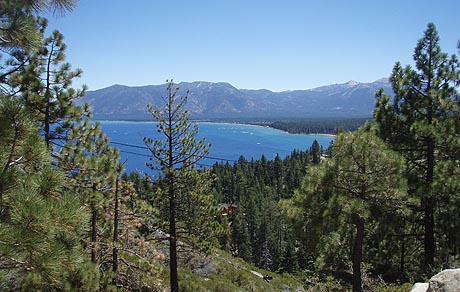
The first peek at Lake Tahoe from high up is always breathtaking, and this day the air was so clear that it sparkled in a deep, deep blue and you could see forever. For a while Route 50 and Route 89 go together towards Lake Tahoe, then, once you reach the lake, 89 goes up north along the Western shore of Lake Tahoe, up and down the mountain sides with such majestic vistas that you feel tempted to stop again and again to take pictures. We did have enough cameras on board for that, of course, and so it was almost noon by the time we'd successfully located the small Meeks Bay park about five miles north of Emerald Bay. There is no ranger station, but just a machine that spits out a ticket in exchange for a five dollar bill. That's more than fair for a day's worth of fun at Lake Tahoe. I had been a bit concerned about finding parking as there are but a couple dozen spots, but we all got lucky.
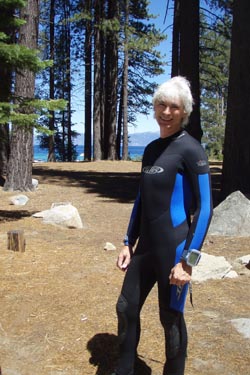 So then it was time to lay out the diving gear and for me to begin the usual struggle with my 7mm Telos wetsuit. Though it was only 80 degrees or so, the sun was burning down and the air at Lake Tahoe -- 6,230 feet above sea level -- is a good deal thinner than I'm used to. After a lot of grunting and the occasional swearword or two we're all suited up, steel 95s on our backs, and we walk on over to the beach.
So then it was time to lay out the diving gear and for me to begin the usual struggle with my 7mm Telos wetsuit. Though it was only 80 degrees or so, the sun was burning down and the air at Lake Tahoe -- 6,230 feet above sea level -- is a good deal thinner than I'm used to. After a lot of grunting and the occasional swearword or two we're all suited up, steel 95s on our backs, and we walk on over to the beach.
We see a trio of divers that had just returned from a dive and so we stop by to say hello. At Tahoe you know the visibility is great -- no need to ask -- and so we inquire about the temperature instead. 67 degrees Fahrenheit at the surface, but just 55 or so at 90 feet they say. Yes, hoods and gloves would be a good thing; they'd worn them. We'd brought those along, but it's hard to see them as necessary when you're sweating like a pig and about to have a heatstroke, so they remained in the car. All I heard was 90 feet. They had actually gone down the slope to 90 feet at Meeks Bay?! I remembered the sandy, featureless drop descending at a 45 degree angle and how it had felt a bit scary for me to descend to 58 feet last Fall.
A good number of people enjoy the pristine beach, but it isn't too crowded. We can't wait to get into the clear water and it does feel good. I cool off, recover from walking from the parking lot to the water in my wetsuit and all my gear, put on my fins (still always a struggle after all this time) and then it's time to go under. I carry 12 pounds of weight total -- two 4 pound bags in the left and right pockets of my weight-integrated Scubapro Knighthawk BC, and two 2 pound baggies in the back/shoulder pockets of the BC.
We descend to the sandy bottom at 15 feet or so. I am breaking my own rule of never wearing a new (to me) mask on a real dive by using one that has built-in corrective lenses so I can better see my dive computer and the controls and screen of my camera. It's an interesting design, with the bottom of the mask lens consisting of two magnifying pieces of glass at an angle so you can look down at your instruments or dive computer. I give it a quick test. I can clearly see and read the LCD display of my UWATEC SmartZ dive computer, and also the tiny controls of the Olympus 770 SW underwater camera I'd brought along. The mask isn't fogging up and it seems to have a good enough fit for the shape of my head that it doesn't leak. However, the straight lines where the two glass panes meet is distracting and I have to tilt my head more, and can see less, than I expected.
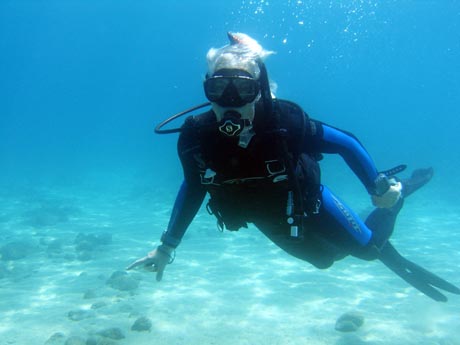
Someone apparently had some fun on the sandy bottom. Perhaps decompressing, they'd written "BE GOOD" with brick-sized rocks, and also "GT" and I wonder if that is in reference to a diver's car (such as my PT Cruiser GT). But on we move, out to the buoy where we're supposed to take a right so as to stay clear of the marina with its boats. Meeks Bay is on the California side of Lake Tahoe, and so a dive flag isn't required, though the regulations -- which I had looked up -- are exceedingly murky and confusing.
The water feels good. Cool and refreshing rather than cold. About eight minutes into the dive we reach the slope, but it isn't like what I had seen last year. It's not the sandy, featureless 45-degree slope. Instead, we're farther south where the huge rocks and boulders are. I look around and it's beautiful. The visibility must be over 100 feet. I hover amidst hundreds or thousands of glistening little fish, schools of minnows perhaps. It feels like sitting in an IMAX theater and watching an underwater movie where the fish are all around you and you feel you can just reach out and touch them. Except that this is real. But instead of your hand going through the 3D IMAX fish, these live ones simply dart out of the way. I could have just hung there in wonder, watching those fish and the giant boulders.
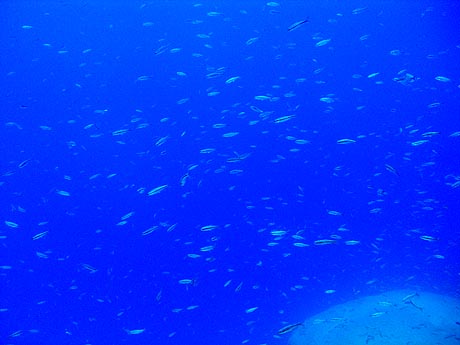
But we move on and are now on a rather steep slope with huge boulders, very different from what I saw last year. There is apparently more to Meeks Bay than I first though. It is not just a simple beginner's dive.
For some reason I am not 100% comfortable. The mask with its optical inserts narrows my field of vision, something which I don't like at all. I take some pictures with the Olympus 770 but don't pay much attention to it. We stop at around 70 feet, deeper than I had ever gone before. I still don't feel quite right. The visibility is great, so that is not it. But as we stop I am very aware that we have 70 feet of water above us and for a moment I wonder what would happen if something went wrong with my body or I panicked. Staying put gives me time to think about this and I don't like it. So I hover and swim around to shake off the uneasiness until it's time to move on.
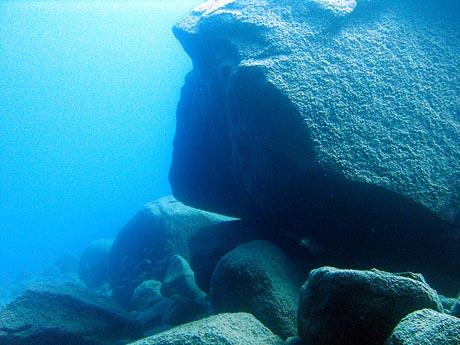
We're going deeper and it's getting pretty cold now. My dive buddy gives me a sign but I can't quite figure out what she's trying to tell me. She motions for me to follow, but I am at 94 feet already and don't feel like descending deeper. She does, takes a picture with her Casio S500 in its deepwater case, then returns and points at her dive computer. She'd gone to 100 feet in Lake Tahoe. Given that we would have to return up to the 7,440 foot summit, which is rounded up to 8,000, 100 feet represents an altitude-adjusted depth of 134 feet in the Altitude-Adjusted Dive Depths tables. Later I'd wonder if perhaps I'd felt a bit of nitrogen narcosis. I didn't feel weird or euphoric or paranoid, but it also never occurred to me that I was holding the Olympus 770 camera in my hand, the one rated at 33 feet but that had accompanied me without ill effects down to 67 feet at Manatee Springs State Park. This was almost 30 feet deeper.
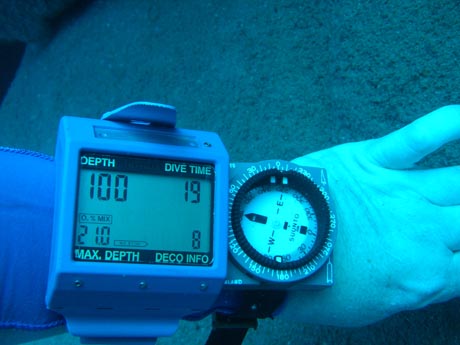
For the next ten minutes we slowly ascend, weaving our way through and around all those rocks and boulders until we're back up at 30 feet. The temperature quickly rises from 55 to 66 degrees, but by now I am cold. We again see the schools of little silvery fish and occasionally a bigger one, and some pretty sizable crawdads. They are usually feisty fellows, swinging their claws at us and definitely not willing to give an inch.
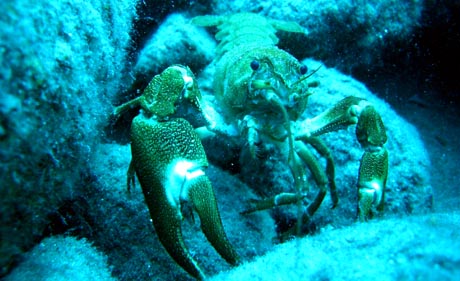
We continue exploring for another ten to 15 minutes at around 20 feet and then it happens: I am unable to dump air from my Knighthawk BC and feel myself rising. I hold up my Air2 with its dump valve, but no matter how hard I push, no air comes out. I try to swim down, but it's too late. I am already at the surface. No real big deal, but I am upset with myself!
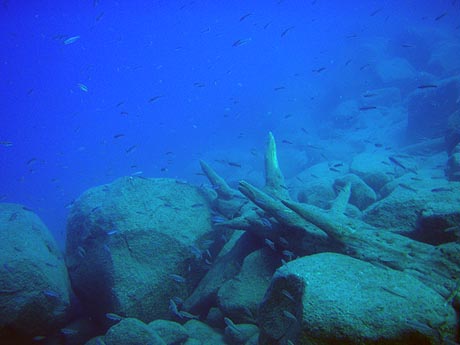
Now I am really cold, with my whole body just shivering away. We get out of the water, and then just sit for a while, recovering. It'd been a great dive. There aren't too many places with 100+ feet of visibility, grand underwater vistas, the ability to go as deep as you're comfortable with, and it's all easily reachable from the shore. In addition, the water is crisp and clean and clear. What more can one ask for?
Posted by conradb212 at 11:17 PM
August 6, 2007
First Scuba certification anniversary and diving Tahoe again
Time flies. Exactly a year ago I received my PADI Open Water certification at Folsom Lake. It seems like a lifetime ago. I look at the picture of my instructor, Chuck Odell, with his arms outstretched, proclaiming, "You are now certified!" Back then I didn't know what to expect. Everyone had told me about the camaraderie among dive class graduates, and how we should keep in touch and go dive together. And, of course, how our local dive shop, the place where we learned and got certified, would have all those trips and opportunities. Well, my class, small to begin with, showed no interest in keeping in touch. I tried, sending everyone emails, but that all quickly fizzled. And my dive shop went under a few days after I got certified. Sure, some of the folks who got stranded when the dive shop tanked got together and formed their own loosely knit group. I even did their website and attended the initial meeting. But they were mostly couples who had known, and vacationed with, each other for decades. I probably could have become part of that group, but for whatever reason, I didn't.
So it's a year later, and as with everything else in my life, I don't know whether I succeeded or bombed. I certainly didn't drop out of diving like so many newly certified divers do. I do have 27 dives in my log book, and have spent a total of 806 minutes underwater, 13-1/2 hours. I got my advanced NAUI certification, and have seen some very interesting places. And the scubadiverinfo.com website certainly has grown. I've written some 65,000 words of blog entries alone, and site traffic keeps growing. On the negative side, it's a year later and I have just 27 dives under my belt (or integrated weight system), and four of them were the certification dives. That's not exactly a whole lot in a year, and I still haven't even tasted salt water. All my dives have been in lakes and rivers and sinkholes. I certainly read and learned a lot, and it's been a thoroughly interesting experience. But not having a local dive buddy certainly meant fewer dives than I had anticipated.
But now the next trip is planned. It's Lake Tahoe again. SeaLife is sending me three of their latest underwater cameras for review, and the big Olympus Evolt rig certainly needs to get back in the water. I also have four other new cameras that need to be reviewed, and what better place than Tahoe?
So that means I have to think about high altitude diving again. Sadly, I never did get the PADI high altitude diver card Chuck had said I had earned. I reminded him a few times, but life got in the way, and I think he moved elsewhere. Oh well. In any case, I've been thinking about high altitude diving and what it means.
It's actually an interesting topic with several aspects. I had given it a lot of thought last year before I dove Tahoe with Chuck. So much that his curt reply to my long email was "You're overthinking!" Well, as far as I am concerned, that's better than underthinking. Anyway, the issue with high altitude diving is that the sea level dive tables don't apply. Why is that?
Well, Lake Tahoe is at 6,230 feet, and at that altitude, the air pressure is only about 80% that of sea level. So if you dive down to, say, 66 feet, the 66 feet of water add the usual two atmospheres of pressure. But when you ascend again, you don't go from the usual three atmospheres to one, absolute. Instead, you emerge to an air pressure of only 0.8 atmospheres. So as far as nitrogen absorption goes, it's as if you had done a dive not down to 66 feet, but to 1.2 times 66 feet, or 80 feet. But, you may say, what if prior to the dive you had stayed at high altitude long enough to have off-gassed enough nitrogen to be at an equilibrium? Admittedly, to my way of thinking, the 66 foot dive should then be just a 66 foot dive. But that's not the way high altitude dive tables see it. In fact, they're even based on not only the water level of where you are diving, but the highest elevation you'll be going 24 hours after a dive. So if you drive back over an 8,000 foot mountain pass where air pressure is just over 75% of that at sea level, your 66 foot dive is now considered 1.25 x 66 feet, equals 88 feet. Now, that is just my way of reckoning. The altitude dive tables I've seen are even a bit more conservative. It's also recommended to only do two dives a day, and that safety stops are mandatory.
But there's more. I'll be driving up from Folsom, which is at just 300 feet or so. So by the time I arrive the summit, the pressure will be much lower, and my body will be off-gassing. Using the PADI pressure group system, each 1,000 feet of elevation is equivalent of two pressure groups, so at the 8000 foot summit, that'll be 16 pressure groups. So up there you're all of a sudden a PADI "P" diver and it'll take your body so and so much time to off-gas and reach equilibrium. But wait, I'll quickly be descending again to Tahoe lake level, and then it'll be perhaps an hour and a half until I actually hit the water. The PADI table would indicate that I am now a "C" diver, which is why every altitude dive should be considered a repetitive dive, even the first. It's easy to see how this can quickly become complicated, so better safe than sorry.
There's actually an additional interesting aspect: In terms of ACTUAL pressure, at our depth of 66 feet, it's really less. Instead of the weight of 66 feet of water and then a whole atmosphere of air pushing down on us, it's just the water and then 80% of what the air normally contributes, so from that perspective, the 66 foot dive is actually more like a 66 divided by 3 times 2.8 dive, or 61.6 feet. But since it is the nitrogen we're concerned about, this means nothing.
Posted by conradb212 at 11:16 PM








